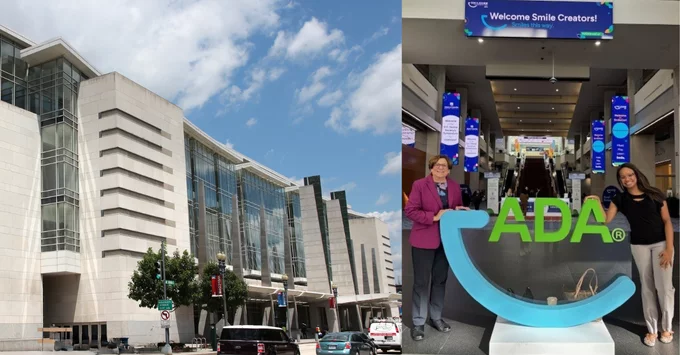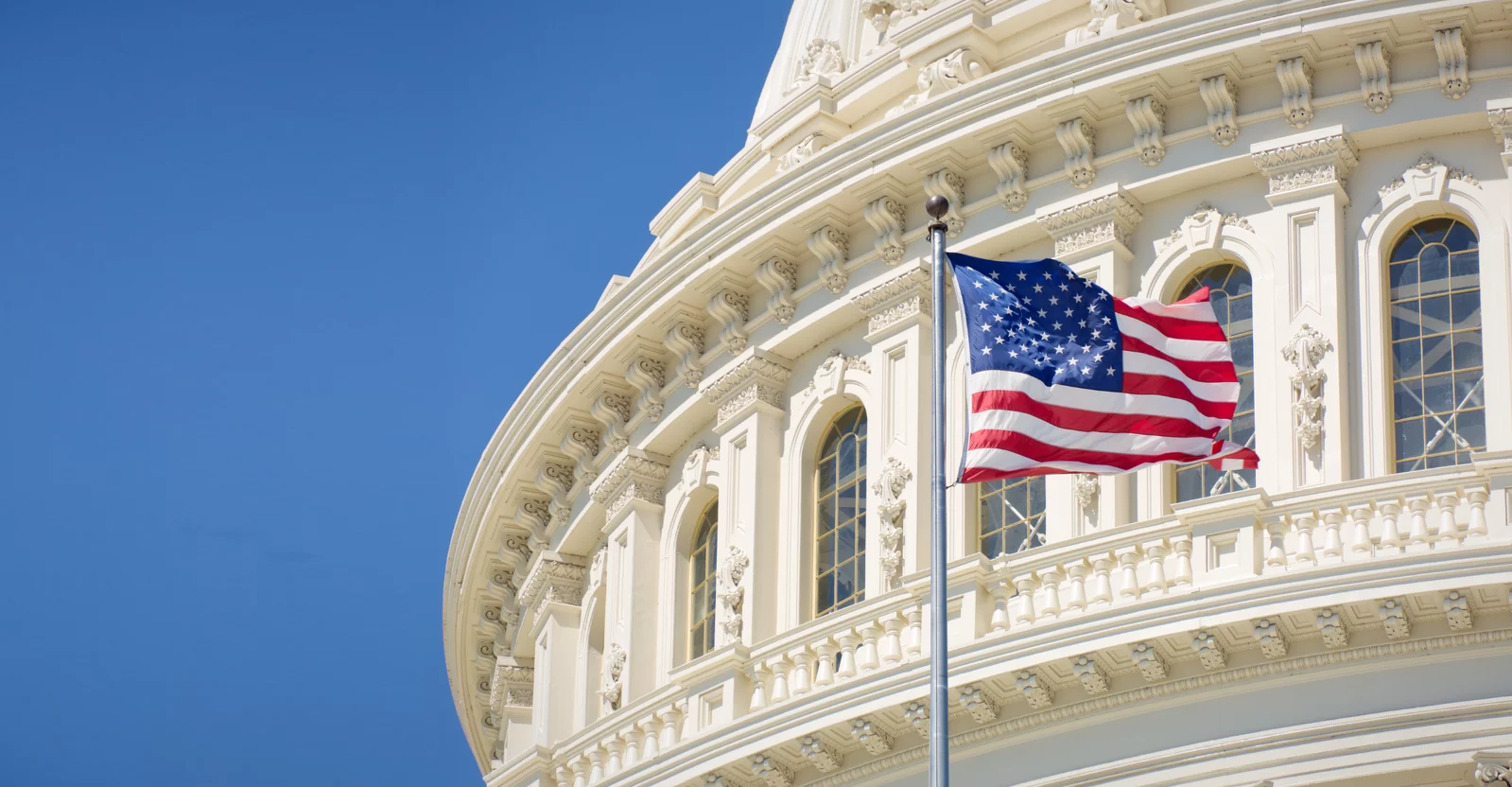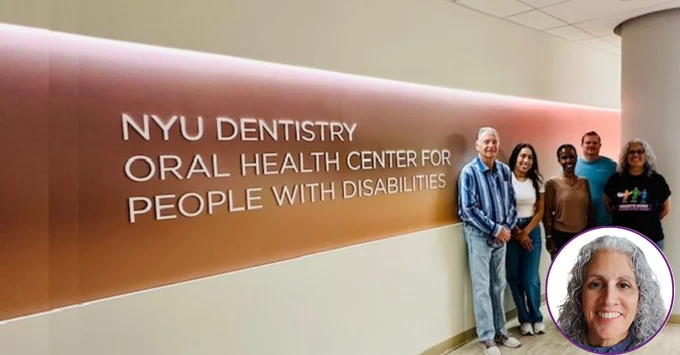By Bronwyn Barrera, MBA, ADHA Staff
November 10, 2025
The American Dental Association’s (ADA) position on dental hygiene education, scope of practice, and workforce definitions became unmistakably clear at its House of Delegates meeting October 25–28 in Washington, D.C.
The American Dental Hygienists’ Association’s (ADHA) advocacy team—Dr. JoAnn Gurenlian, Director of Education, Research, and Advocacy, and Katherine Williamson, Senior Manager of Advocacy—attended, and submitted ADHA’s formal testimony on four resolutions, witnessing firsthand how outside voices factor into the ADA’s policy decisions: they don’t.
Why ADHA Attends

ADHA advocacy staff, Dr. JoAnn Gurenlian and Katherine Williamson, attend the ADA House of Delegates in Washington D.C. ahead of the association’s final SmileCon conference.
ADHA’s presence at the ADA House of Delegates serves a specific purpose: situational awareness. Understanding the policy decisions being made by organized dentistry helps ADHA better serve members and anticipate challenges ahead.
Attending also establishes ADHA’s formal record of engagement.
Standing Firm on Professional Standards
ADHA submitted testimony on four resolutions, supporting two focused on women’s oral health research and maternal care, while opposing two that raised concerns about workforce standards and professional definitions.
Supporting Women’s Health: ADHA voiced strong support for Resolution 330, which encourages regular dental examinations and treatment for pregnant women throughout all stages of pregnancy, and Resolution 331, which supports increased funding for women’s oral health research. Both resolutions align with ADHA’s commitment to advancing equitable access to preventive care and evidence-based practices.
Protecting Education Standards: ADHA opposed Resolution 324, which included language suggesting that dental hygiene licensure could allow graduation from “equivalent” programs rather than strictly CODA-accredited ones. ADHA’s testimony was clear: CODA-accredited programs are the nationally recognized standard for dental hygiene education, ensuring the rigor, consistency, and accountability necessary for safe patient care. Allowing undefined “equivalent” programs would introduce variability and undermine professional standards.
The same resolution also opposed licensure for dental assistants, framing it as a barrier to entry. ADHA countered that licensure is essential to ensure dental assistants are properly trained, qualified, and accountable—all critical factors for patient safety and professional standards across the dental team.
Additionally, Resolution 324 expressed potential support for Oral Preventive Assistant (OPA) pilot programs. ADHA’s testimony opposed ADA support for OPA pilot programs, noting these programs often lack valid assessments demonstrating improved health outcomes and present clear risks to patient safety.
Updating Outdated Definitions: Perhaps most significantly, ADHA opposed Resolution 325, which proposed a glossary of workforce terms including an outdated definition of dental hygienists. The proposed definition characterized dental hygienists primarily as supervised providers whose functions “always include, at a minimum, scaling and polishing the teeth.”
ADHA’s testimony urged the ADA to reflect the modern scope of dental hygiene practice: today’s dental hygienists are independent, licensed healthcare providers who provide assessment, diagnosis, planning, implementation, evaluation, and documentation of patient care.
The Outcomes
ADHA’s recommendations were not adopted by the House of Delegates. In fact, it seemed that testimony from outside organizations—including ADHA, the American Dental Education Association, and state dental directors—wasn’t considered by the committees reviewing proposed resolutions. As Williamson observed, the formal testimony “was truly a formality. It wasn’t considered by any of the committees.”
ADHA accomplished what was possible: establishing a formal record of the association’s position and gaining firsthand knowledge of where the ADA is heading on workforce and scope of practice issues. The resistance to outside input is particularly concerning given the economic realities dentistry faces.
Economic Context
ADHA’s testimony on professional standards and education requirements comes at a time when dentistry faces significant workforce challenges. According to the ADA’s Health Policy Institute Q3 2025 report on the state of the U.S. dental economy, more dentists report they’re not busy enough—35% in Q3 2025, up from 28% the previous quarter. Appointment wait times for new patients dropped to just over 12 days, the lowest in over three years.
Yet one in three dentists reported recruiting dental hygienists in Q3 2025, with 90% saying recruitment was very or extremely challenging—a statistic unchanged for three years. Among positions successfully filled, one-fifth had been open for more than six months.
The ADA’s own Health Policy Institute research documents why recruitment remains difficult: retention issues. The ADA HPI’s 2022 Dental Workforce Shortages report, conducted in collaboration with ADHA and other partners, identified the top factors driving dental hygienists to leave positions: negative workplace culture, lack of growth opportunity, inadequate benefits, feeling overworked, communication concerns, and insufficient pay. Retention is far less expensive than recruitment, yet the focus remains on filling positions rather than addressing why they empty in the first place.
These realities make ADHA’s opposition to lowering education standards particularly relevant. The profession doesn’t need shortcuts to licensure—it needs sustainable workplace conditions that value properly trained professionals.
The Power of $10
The ADA’s advocacy funding goal: $2 million. During the House of Delegates meeting it was announced that the ADPAC had raised $1.6 million toward their goal of $2 million this year, with California contributing $80,000.
ADHA could achieve similar impact. If every dental hygienist of the 220,000 in the U.S. contributed just $10, the association would have $2.2 million for advocacy—enough to expand federal presence, hire more lobbyists, provide more state-level support, add advocacy staff capacity, and fund lobby days where members meet directly with their elected representatives.
Contributions strengthen ADHA’s ability to engage with policymakers and protect the profession. Every contribution—$5, $10, or more—increases ADHA’s advocacy capacity.
Looking Ahead
ADHA’s advocacy team will continue monitoring ADA policy decisions and submitting testimony where appropriate. When the ADA House of Delegates releases its final resolutions and outcomes, ADHA will share the relevant information.
ADHA staff’s experience returning to the ADA House of Delegates this year reinforced an important lesson: ADHA’s most effective advocacy happens not in testimony that goes unconsidered, but in direct engagement with lawmakers, support for state associations facing legislative battles, and building coalitions with organizations that recognize dental hygienists as the independent healthcare professionals they are.
____________________________________
Bronwyn Barrera, MBA is the director of the ADHA’s Marketing & Communications Department. She can be reached at [email protected].



